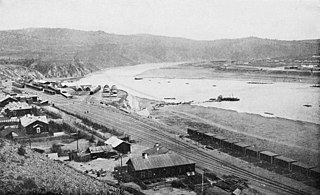Related Research Articles

The Ukrainian Canadian internment was part of the confinement of "enemy aliens" in Canada during and for two years after the end of the First World War, lasting from 1914 to 1920, under the terms of the War Measures Act.
In customary international law, an enemy alien is any native, citizen, denizen or subject of any foreign nation or government with which a domestic nation or government is in conflict and who is liable to be apprehended, restrained, secured and removed. Usually, the countries are in a state of declared war.
German Australians are Australian citizens of ethnic German ancestry. The German community constitute one of the largest ethnic groups in Australia, numbering 898,700 or 4.5 percent of respondents in the 2011 Census. It is the fifth most identified European ancestry in Australia behind English, Irish, Scottish and Italian.
A civilian internee is a civilian detained by a party to a war for security reasons. Internees are usually forced to reside in internment camps. Historical examples include Japanese American internment and internment of German Americans in the United States during World War II. Japan interned 130,000 Dutch, British, and American civilians in Asia during World War II.

Trial Bay Gaol is a heritage-listed former public works prison and internment camp at Cardwell Street, Arakoon, Kempsey Shire, New South Wales, Australia. The property is owned by the NSW National Parks and Wildlife Service. It was added to the New South Wales State Heritage Register on 14 May 2010.

Internment of German resident aliens and German-American citizens occurred in the United States during the periods of World War I & World War II. During World War II, the legal basis for this detention was under Presidential Proclamation 2526, made by President Franklin Delano Roosevelt under the authority of the Alien Enemies Act.

The Torrens Island Internment Camp was a World War I concentration camp, located on Torrens Island in the Port River Estuary near Adelaide in South Australia. The camp opened on 9 October 1914 and held up to 400 men of German or Austro-Hungarian background, or crew members of enemy ships who had been caught in Australian ports at the beginning of the war. They were held without trial under the provisions of the War Precautions Act 1914.

Although short-lived, the Eaton Internment Camp was one of twenty-four official internment facilities created in Canada to accommodate prisoners of war during the period 1914-20. It was the only facility of its kind in the province of Saskatchewan.

The Castle Mountain Internment Camp, located in Banff National Park, Alberta, was the largest internment facility in the Canadian Rockies, housing several hundred prisoners at any one time. Established on July 13, 1915, a total of 660 enemy aliens were interned at the facility during its entire operation.

George Kenner was a German artist. He made 110 paintings and drawings during the First World War while interned as a German civilian prisoner of war in Great Britain and the Isle of Man.

Holzminden internment camp was a large World War I detention camp (Internierungslager) located to the north-east of Holzminden, Lower Saxony, Germany, which existed from 1914 to 1918. It held civilian internees from allied nations. It was the largest internment camp in Germany, and in October 1918 held 4,240 civilians.
Amherst Internment Camp was an internment camp that existed from 1914 to 1919 in Amherst, Nova Scotia. It was the largest prisoner-of-war (POW) camp in Canada during World War I; a maximum of 853 prisoners were housed at one time at the old Malleable Iron foundry on the corner of Hickman and Park Streets. The most famous prisoner of war at the camp was Leon Trotsky. There was a commemoration of the guards and prisoners for the 100th anniversary of the closing of the Amherst POW Camp on July 2, 2019, at the Amherst Armoury.

During World War I in Queensland, Australia, enemy aliens were frequently arrested and detained. Strong anti-German sentiment resulted in many arrests and investigations. German place names in Queensland were frequently renamed with British names.

Sretensk was a Russian prisoner-of-war camp established in October 1914 with the intent of housing Central Powers' troops captured during the course of World War I. The camp was situated in the city of Sretensk and combined barracks and private residences to house the internees. The internal affairs of the camp were regulated by a committee of interned officers and the camp authorities. Between December 1915 and March 1916 the camp was affected by a typhus epidemic. Following the abdication of Nicholas II of Russia in February 1917, conditions in the camp worsened. A number of prisoners joined rival factions during the Russian Civil War while those who remained came under fire when the fighting spread to the camp. The last prisoners were evacuated from the camp in the middle of 1921.
The British government was initially reluctant to impose widespread internment in the United Kingdom during the First World War, choosing instead to restrict the activities of nationals of enemy nations residing in the UK and interning only those suspected of being a threat to national security. Public anti-German sentiment peaked with the sinking of the RMS Lusitania on 7 May 1915, and the subsequent rioting forced the government to implement a general program of internment.

Berrima Internment Camp Huts Area is a heritage-listed former internment camp site at Argyle Street, Berrima, Wingecarribee Shire, New South Wales, Australia. It formed an additional section of the former Berrima Internment Camp outside the walls of the Berrima Gaol. It was established from 1915 to 1918. The camp was also known as the Berrima PoW Camp, the German Detention Camp and the German Concentration Camp. It was added to the New South Wales State Heritage Register on 14 January 2011.

The history of the Jews in the Isle of Man goes back to at least the early 19th century.